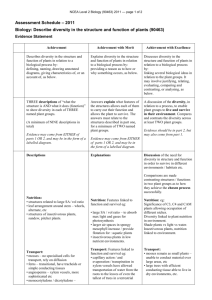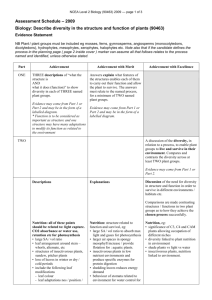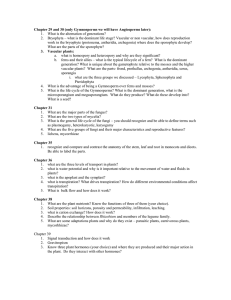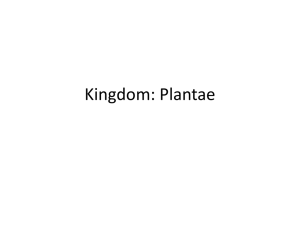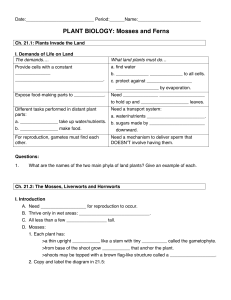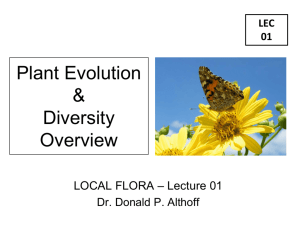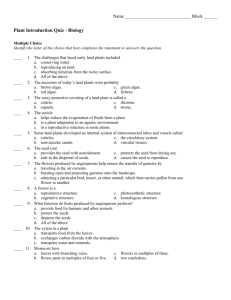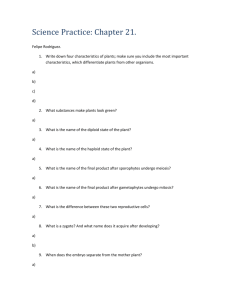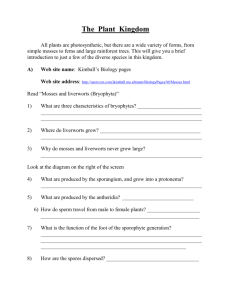46KB - NZQA
advertisement
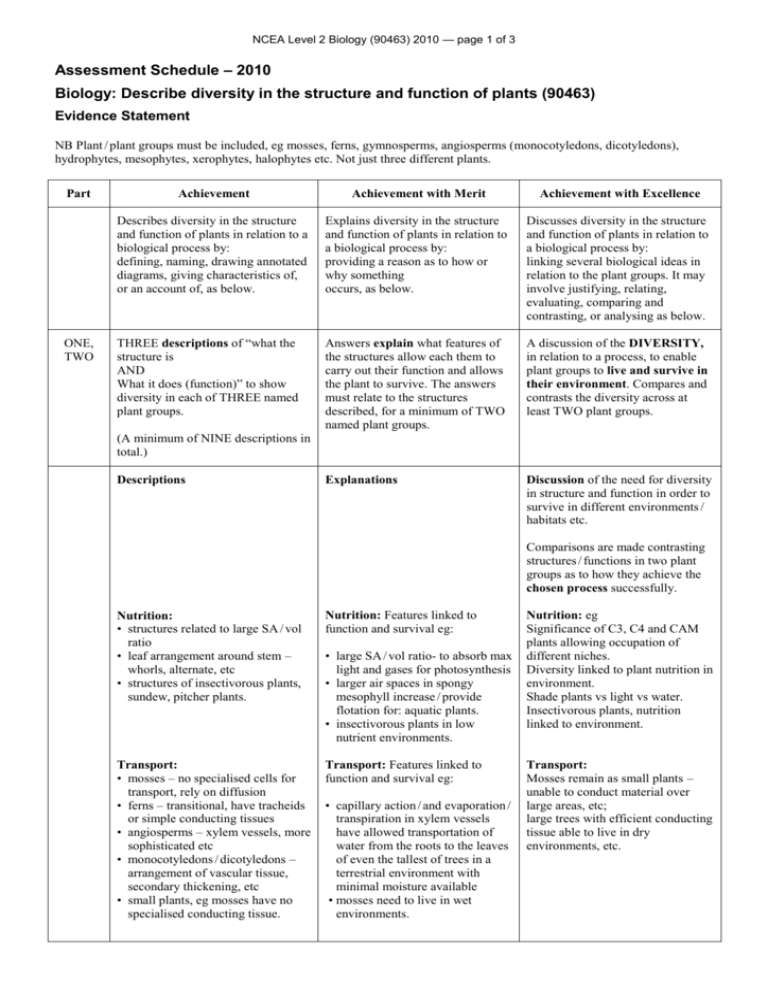
NCEA Level 2 Biology (90463) 2010 — page 1 of 3 Assessment Schedule – 2010 Biology: Describe diversity in the structure and function of plants (90463) Evidence Statement NB Plant / plant groups must be included, eg mosses, ferns, gymnosperms, angiosperms (monocotyledons, dicotyledons), hydrophytes, mesophytes, xerophytes, halophytes etc. Not just three different plants. Part ONE, TWO Achievement Achievement with Merit Achievement with Excellence Describes diversity in the structure and function of plants in relation to a biological process by: defining, naming, drawing annotated diagrams, giving characteristics of, or an account of, as below. Explains diversity in the structure and function of plants in relation to a biological process by: providing a reason as to how or why something occurs, as below. Discusses diversity in the structure and function of plants in relation to a biological process by: linking several biological ideas in relation to the plant groups. It may involve justifying, relating, evaluating, comparing and contrasting, or analysing as below. THREE descriptions of “what the structure is AND What it does (function)” to show diversity in each of THREE named plant groups. Answers explain what features of the structures allow each them to carry out their function and allows the plant to survive. The answers must relate to the structures described, for a minimum of TWO named plant groups. A discussion of the DIVERSITY, in relation to a process, to enable plant groups to live and survive in their environment. Compares and contrasts the diversity across at least TWO plant groups. Explanations Discussion of the need for diversity in structure and function in order to survive in different environments / habitats etc. (A minimum of NINE descriptions in total.) Descriptions Comparisons are made contrasting structures / functions in two plant groups as to how they achieve the chosen process successfully. Nutrition: • structures related to large SA / vol ratio • leaf arrangement around stem – whorls, alternate, etc • structures of insectivorous plants, sundew, pitcher plants. Nutrition: Features linked to function and survival eg: Transport: • mosses – no specialised cells for transport, rely on diffusion • ferns – transitional, have tracheids or simple conducting tissues • angiosperms – xylem vessels, more sophisticated etc • monocotyledons / dicotyledons – arrangement of vascular tissue, secondary thickening, etc • small plants, eg mosses have no specialised conducting tissue. Transport: Features linked to function and survival eg: • large SA / vol ratio- to absorb max light and gases for photosynthesis • larger air spaces in spongy mesophyll increase / provide flotation for: aquatic plants. • insectivorous plants in low nutrient environments. • capillary action / and evaporation / transpiration in xylem vessels have allowed transportation of water from the roots to the leaves of even the tallest of trees in a terrestrial environment with minimal moisture available • mosses need to live in wet environments. Nutrition: eg Significance of C3, C4 and CAM plants allowing occupation of different niches. Diversity linked to plant nutrition in environment. Shade plants vs light vs water. Insectivorous plants, nutrition linked to environment. Transport: Mosses remain as small plants – unable to conduct material over large areas, etc; large trees with efficient conducting tissue able to live in dry environments, etc. NCEA Level 2 Biology (90463) 2010 — page 2 of 3 Transpiration: • modified leaves; curled, reduced (stem also photosynthetic eg broom) • leaves absent, cacti • stomata; sunken, upper / lower leaf • deciduous plants / over-wintering Transpiration: Features linked to function and survival eg: • curled leaves prevent transpiration because the inside of the leaf develops a high humidity, which reduces the concentration gradient, therefore less transpiration • similar for sunken stomata • link these to reduced water loss and dryer environments. Transpiration: • adaptations linked to the environment • diversity in carrying out the same process in different environments. Reproduction: Reproduction: Features linked to function and survival eg: Mosses • gametes flagellated in mosses, in wet environment • spores light, produced in large numbers carried by wind • photosynthetic gametophyte supports the sporophyte. Reproduction: • Significance of the increasing dominance of the sporophyte generation. • the significance of the mechanisms to increase genetic variability within the species • complexity of floral structures relevant to increasing specialisation of pollination / mutualistic relationships • sperm / flagellated gametes suitable in a wet environment • wind pollination suitable in windy environment when large numbers of the species are present, etc. • Mosses Main plant gametophyte Produce antheridia and archegonia (at tips of gametophyte) Produce sperm (gametes) – Sporophyte attached to base of gametophyte produces spores, etc. • Ferns Dominant phase – sporophyte Prothallus structure produces antheridia and archegonia Structure of sporangia – mechanism for release of spores. Ferns • mechanism for release of spores • prothallus – antheridia release sperm swim to archegonia, etc still need for moisture. • Gymnosperms Male / female cones Seed structure, etc. Gymnosperms • location and function of cones • quantity of pollen produced • seed structure for movement in air currents, etc. • Angiosperms Wind pollinated Insect pollinated Specialisation of floral structure for fertilisation by specialised pollinator. Angiosperms • endosperm to feed developing embryo / prolong survival, also role of testa to protect seed • temporal and spatial separation of male and female (pollen / ovule) gamete reproduction • details of mechanisms of pollen dispersal small light / rough / sticky • energy saved / used to produce nectar / pollen / floral structures • mechanism for sperm transfer through pollen tube, reducing chance of desiccation • flower structures advantages to increase chances of pollination, etc. NCEA Level 2 Biology (90463) 2010 — page 3 of 3 Judgement Statement Achievement Description of the structures AND their functions for THREE named plant groups, in relation to a biological process. A minimum of 9 descriptions in total. Achievement with Merit Explains what features of the structures allow them to carry out their function. TWO out of THREE plant groups explained sufficiently. Achievement with Excellence Discussions link the need for diversity to survive in a range of environments / habitats / conditions. Must compare and contrast between at least TWO plant groups.
